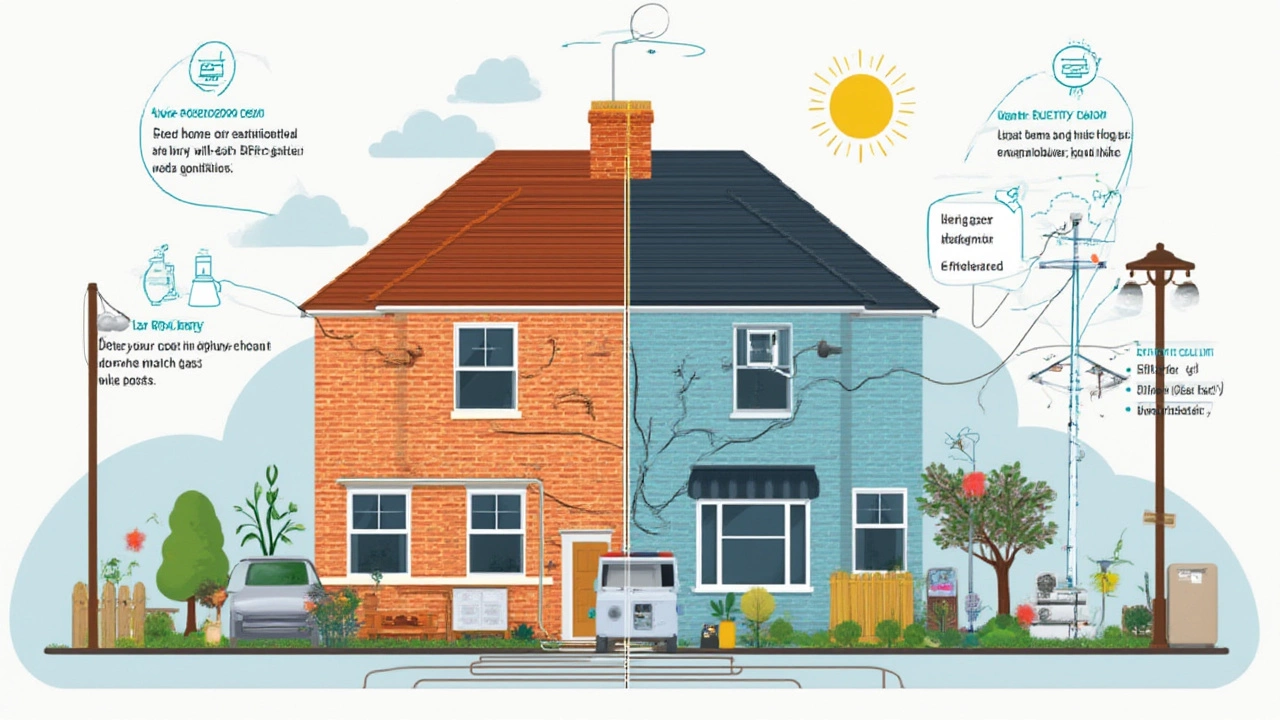Fire departments respond to nearly 50,000 home fires each year caused by gas appliances. Nearly every month brings another headline about cities banning new gas hookups. If you still have a gas stove, heater, or water heater, you’re probably wondering if you should be the last one clinging to that blue flame, or if it’s time to pull the plug—or maybe twist the valve shut—once and for all.
Rethinking Gas: Why the Push for Change?
It’s been a wild few years for gas in the news. Dozens of cities in the US have banned new gas hookups—Berkeley started it in 2019, then cities like Seattle, New York, and San Francisco joined in. This shift isn’t just trendy. The International Energy Agency said in 2022 that gas appliances account for 13% of global household carbon emissions. Whenever you turn on that gas stove or blast the heat from a gas furnace, you’re adding to the problem.
Hospitals and public health researchers have come in swinging too. The Rocky Mountain Institute found that homes with gas stoves can have up to 50% higher indoor nitrogen dioxide (NO2) levels than homes with electric ones. NO2 isn’t just a scary acronym—it’s linked to childhood asthma and all sorts of respiratory trouble, especially in small homes and apartments where ventilation is minimal. No surprise, some pediatricians are swapping their own gas stoves for induction ranges.
Beyond the air you breathe, there’s safety. According to the US Consumer Product Safety Commission, gas leaks from appliances are a key reason for nearly 4,200 injuries and $133 million in property damage each year. The risk isn’t just leaks—carbon monoxide poisoning takes hundreds of lives each year in the US, much of it linked to malfunctioning gas appliances or poor ventilation.
The cost angle’s shifting too. A decade ago, gas was consistently cheaper than electricity for heating and cooking. But by late 2024, things flipped in a lot of regions thanks to booming solar and wind power. In California and New York, electricity rates for average homes with heat pumps and induction ranges are now 20%-30% lower than homes sticking with all gas, according to local utility reports. And gas prices have become more volatile since 2022 due to everything from geopolitics to natural disasters.
If you’re worried that ditching gas means losing that nostalgic “real flame” for your Sunday sauce or chilly winter night, you’re not alone. But the practical reasons for switching are starting to outweigh even the best chef’s emotional attachments.
Unpacking the Pros and Cons: Gas vs. Modern Electric
Before unscrewing any pipes or ordering a shiny new toaster oven, let’s get clear-eyed about the pluses and minuses on both sides. Gas does have a fan base for good reasons. Instant heat, familiar controls, and no worries about outages if the power grid goes down. Restaurants love the responsiveness for woks and searing steaks. Plus, the cost to run gas water heaters or furnaces has, until recently, been hard to beat in cold climates.
- Gas Pros: High heat output per dollar, proven reliability, fast warm-up for stoves, and often cheaper upfront replacement costs.
- Gas Cons: Leaks mean fire and explosion risk, significant emissions, indoor air pollution, aging infrastructure, and ever more local laws phasing it out.
- Electric Pros: Zero on-site emissions, improved indoor air, easy integration with solar panels, safer (no risk of gas leaks), and rapidly improving tech—induction cooktops are faster than gas and easier to clean.
- Electric Cons: Upfront appliance costs are higher, older wiring may need upgrades, and you’re vulnerable to power outages unless you have backup batteries or a generator.
Here’s a quick breakdown of typical costs and emissions for common appliances, based on 2024 data from the US Department of Energy:
| Appliance Type | Annual Operating Cost | CO2 Emissions/Yr* | Notes |
|---|---|---|---|
| Gas Furnace | $400 | 3,300 lbs | 85% efficiency assumed |
| Electric Heat Pump | $300 | ~500 lbs** | Varies by grid mix |
| Gas Water Heater | $250 | 1,200 lbs | Tank, 60 gal |
| Electric Heat Pump Water Heater | $215 | ~200 lbs** | With modern grid |
| Gas Stove | $40 | 150 lbs | Typical family use |
| Induction Cooktop | $30 | ~30 lbs** | Using clean power |
*CO2 estimates assume average US emissions factors; your region may vary.
**Electric emissions drop as your grid gets cleaner—solar and wind cut this number fast.
One “con” that often pops up: losing cooking performance. But side-by-side tests from 2023—take Consumer Reports versus Gaslandia’s chef challenge—showed induction cooking was actually faster than gas for boiling and low simmering. All without the open flame that makes it easier to, say, burn your hand or shirt. The catch? You’ll need compatible pans (magnetic ones work; no copper or aluminum, unless there’s a magnetic base).

What Happens If You Keep Your Gas Appliances?
Clinging to gas isn’t exactly illegal—except if you’re renovating or building new in cities with bans. But sticking with gas does come with headaches. Appliance repair techs have seen a flood of calls about gas leaks, no-ignition, and strange smells. As of 2025, nearly a quarter of the US localities are requiring annual safety inspections for any home with gas lines. That’s not just more hassle, it’s another bill (about $125/year for a standard “safe-and-sound” checkup in big cities).
Repairs can sting. Replacing a faulty gas valve or fixing a persistent burner problem usually costs more than $250 and, if you’re in a place facing gas phaseouts, replacement parts might take longer to arrive. If your hot water heater or furnace dies, swapping it for another gas unit is getting harder—more stores are going electric-only, especially in places like Los Angeles and Portland.
You also keep the downsides: health worries, emissions, and—big surprise here—a possible hit to home value. A Redfin study published in December 2024 showed that homes marketed with “all electric/solar ready” listings in cities with upcoming gas bans sold for 3-5% more than similar properties with legacy gas hookups. Buyers are attracted to the health angle, lower bills, and the idea of a “future-proofed” house.
If you absolutely have to keep one gas appliance for now, make it the one you use the least or upgrade it with all the latest safety gadgets. Invest in good ventilation—install a high-powered range hood, keep your CO alarms working, and get regular inspections done. Also, find the shutoff valve location and show everyone in your house how to turn it off.
Making the Switch: What to Know Before Going All-Electric
Ready to rip out the gas line and go modern? Start with an audit. Take stock of which gas appliances you have and how much you actually use them. Is your dryer gas-powered but you only do laundry once a week? Are you heating a whole house, or is it mostly just hot water and a stove?
Your electric panel may need some love. Old homes with 60-amp service often need upgrading to 100 or 200 amps, especially if you’re adding an induction range and a heat pump. That’s a bigger project—budget $1,500 to $4,000 depending on complexity and local labor costs.
Appliance costs are coming down but still hurt upfront. According to EnergySage data from early 2025, a high-end induction stove costs about $1,400 before rebates; a heat pump water heater runs $1,500, and a ductless mini-split heat pump goes for $3,000-$5,000 per room zone. But keep your eyes peeled for city, state, and federal incentives. The 2024 Inflation Reduction Act means you could get $840 back on induction ranges, $1,750 for heat pump water heaters, and thousands more for whole-house electrification. Some rebates apply instantly at checkout—you don’t have to file paperwork or wait for a check.
- Keep your appliances running safe while you still have them—schedule maintenance, install alarms, and improve ventilation.
- Plan the switch: Can you upgrade when your current appliances fail, or are you going for a whole-house overhaul?
- Search for local electrification rebates. Check city, utility, and federal programs.
- Talk to licensed electricians and appliance installers familiar with going all-electric. They know the quirks—like making sure your breaker box doesn’t get overloaded.
- Don’t get suckered by “hybrid” claims on inefficient electric appliances—true induction and heat pump units eat much less power than older resisitive electric stoves or baseboard heaters.
Once you make the leap, odds are you’ll notice faster boiling times, less kitchen heat in summer, cleaner air (sayonara, greasy vent filters clogging every two months), and energy bills that edge lower—sometimes a lot lower. And if your power goes out often, consider a battery backup or generator so you’re not left in the cold.
So, should you get rid of your gas appliances? The momentum, data, and regulations say yes—it’s safer, healthier, and lowering your carbon footprint has never been easier. You don’t have to make the switch all at once, but the sooner you plan, the more you’ll save (and breathe easier) down the road.

